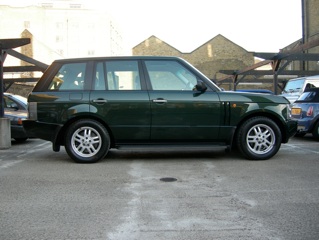Spot the difference. Before and... ...after expedition preparation
RESEARCH
Before making a decision on going with the Rangie I did as much research as I could on what does go wrong with these vehicles. Turning up nothing that particularly put me off (in fact I was surprised at how little seems to go wrong) I proceeded to the preparation phase.
Of huge use in the preparation process were two online forums; rangerovers.net and fullfatrr.com. Many thanks to all who responded to my tedious questions. There was much useful reading to be done on these sites.
Jim Carr at Extreme4x4, who also rallies a RR Sport G4, provided much valuable input also. Thanks Jim. And so did Clive Myall at Bearmach.
Last but not least, I downloaded the workshop manuals for the L322 Range Rover. 650Mb!! For an engineer these are a work of art. The description of the car’s systems runs to 777 pages of highly informative drawings, diagrams and explanation. The service procedures manual is over 1,000 pages, as are the wiring diagrams!!
Yes, this car is terrifyingly complex. But the hardware seems to be up to the job in standard form.
PREPARATION
After talking to a few 4x4 / overland preparation companies it was clear who should do the job: Nene Overland. Nene had relatively little L322 experience (for that matter no one does really) but Kevin and Kurt made sure a good job was done, keeping surprisingly calm despite my endless lists, check-lists etc...
The decision was taken to keep the car as standard as possible, with three major elements to the work:
1. Servicing: the car was given an extremely thorough service, changing engine, gearbox and differential oils plus all filters and attending to anything that looked like it might need attention, especially cooling, fuel and suspension systems. We replaced a few bushes in the front suspension and found and fixed a leak in the air conditioning system. We put a mesh guard in front of the intercooler radiator as it looked vulnerable to big stones and we better shielded the wiring harnesses for the front height sensors. But that was the extent of the modifications, leaving the car in essentially showroom specification.
-
2.Accessories: it’s easy to go mad on accessories so we tried hard to keep things to the essential only. This is what we opted for:
- 19” wheels to fit Goodyear MTR tyres plus 2x spares. Used on the G4 Challenge cars, up to African road conditions and excellent off road capability, these tyres are probably the single most important change we made to the car for Africa.
- Running boards and mudflaps removed for better ground clearance
- Windows tinted to cut down on radiation and prying eyes
- Front lamps guards in case of flying stones (and because they look good ;-)
- A second, deep-cycle, battery and a split charging system. The battery mounts neatly in a compartment in the boot and will run all electrical accessories, protecting the main vehicle battery, but still charged by the engine alternator.
- A fridge! We mounted this in the passenger compartment by removing the smaller section of rear seat - helpful for reaching cool drinks on the move. Pimms anyone?
- Roof rack: A Hannibal rack normally fitted on LR Discoveries was adapted
- Roof tent: A Hannibal roof tent was fitted
- Awning: We fitted a simple awning to provide some shade when stopped
- A whole host of other useful items for operation in remote areas including: external lighting, jerry cans, spade, tow ropes and shackles, an air jack and a 12volt air compressor
Perhaps the most obvious omission is a sump guard. I wanted to fit the G4-spec guard but it is very difficult to find, hugely expensive and very heavy. In the end it was decided that basic ground clearance was good enough (especially at the off-road suspension setting).
-
3.Spares: it’s very difficult to know where to draw the line on spares. You start with a wish list that approximates to virtually taking a second car with you. Then you have to get realistic. How much space have I got? What can I realistically DIY in the middle of Africa? DHL is very good these days... So the major bits I decided I couldn’t do without boiled down to this:
- 1x alternator
- 1x mass airflow meter
- 1x diesel high pressure control valve
- 2x track rod ends
- 2x rear dampers
- 2x service kits (oil, fuel, air, pollen filters)
- 1x accessory drive belt
- 1x a/c compressor drive belt
- various fuses, relays etc
- Hawkeye diagnostic tool in case of electronic maladies
and of course the good old workshop manual (needs a laptop to run these days, no Haynes manual for the L322!) and a list of Land Rover service and parts agents across Africa. Plus tools, WD40, duct tape, oils etc etc...
Expedition prepared Range Rover gallery



